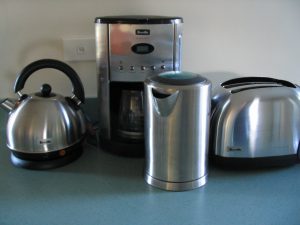When I was growing up, my hometown newspaper ran an informal column in which the readers themselves could write in highlighting a product or item that they used at home that had proved beneficial to their lives somehow and that everyone else should check out: powerful vacuum cleaners, super-duper TV remote controls, and all sorts of kitchen appliances. Readers explained the product's features, how to use it, why it was worth buying, how much it cost, where to buy it, etc. It was a fun, casual way for newspaper readers to interact and "talk" to each other before the Internet came along and changed everything.

I was thinking the other day that this could be a great theme for a speaking activity or project in the world language classroom. Ask your students to identify an item that they regularly rely on or that's simply the best of its kind. (Yes, everyone's first inclination will be to choose their cell phone. Maybe it's a good idea to rule them out altogether or at least ask students to focus on a specific function of their cell phone, like a particular app.) When you set up the assignment, choose "video prompt" and tell students that they'll be appearing on video so they should be able to show the product in question to the camera. Then students can talk at length (however long you as the teacher decide is appropriate) about the product, including the following information:
- What it's called
- How to use it
- How the student discovered it
- Why it's so useful and/or why everyone else should use it too
- Any downsides to using it
- Where to buy it
- How much it costs
The final product may end up sounding more than a little like an infomercial, but that's OK, because it'll only make it more fun (and funny) for everyone. And because everyone in the class will likely be choosing something unique to talk about, it's a great idea to play student submissions in class the following day. Turn it into an in-class listening comprehension activity by asking the students to listen closely to each recording and then vote on various things: coolest product, most convincing "salesperson", least convincing "salesperson", most surprising choice, etc.
As for assessment, there are a couple of ways that you could evaluate the students' work. If strapped for class time, you could make it a formative assessment and grade it along one criterion, such as vocabulary usage or quantity of information. Or, if you'd like to turn it into a meatier summative assessment, consider using our customizable rubrics to ensure that students are keying in on appropriate vocabulary choices, grammatical structures, fluency, and even presentational abilities.
Give this idea a shot and let us know how it goes!


